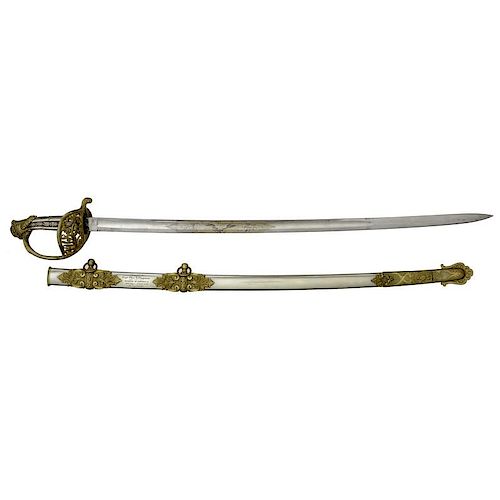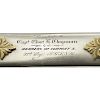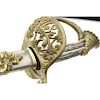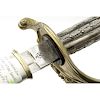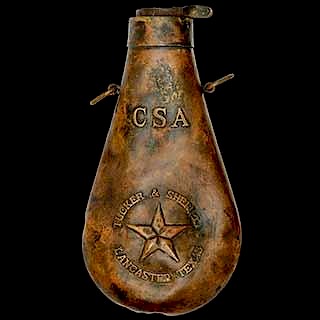Civil War Sword Presented To Captain Charles E. Chapman, 37th NYSM
About Seller
6270 Este Ave.
Cincinnati , OH 45232
United States
With offices in Cincinnati, Cleveland and Denver, Cowan’s holds over 40 auctions each year, with annual sales exceeding $16M. We reach buyers around the globe, and take pride in our reputation for integrity, customer service and great results. A full-service house, Cowan’s Auctions specializes in Am...Read more
Two ways to bid:
- Leave a max absentee bid and the platform will bid on your behalf up to your maximum bid during the live auction.
- Bid live during the auction and your bids will be submitted real-time to the auctioneer.
Bid Increments
| Price | Bid Increment |
|---|---|
| $0 | $25 |
| $500 | $50 |
| $1,000 | $100 |
| $2,000 | $250 |
| $5,000 | $500 |
| $10,000 | $1,000 |
| $20,000 | $2,500 |
| $50,000 | $5,000 |
| $100,000 | $10,000 |
About Auction
May 3, 2017 - May 5, 2017
Cowan's Auctions dawnie@cowans.com
- Lot Description
32" blade with gilt etched panel of E. Pluribus Unum and on the reverse U.S. Blade marked on the ricasso W. Clauberg, Solingen. Fluted silver handle with floral designs. The guard is two branches deeply relief cast and chased with laurel leaf designs over the entire length of each side of the branches. Pommel with deeply chased designs. Scabbard of white brass with deeply chased brass mounts. Drag with deeply chased designs included an Eagle. Brass with gilt finish. Scabbard is in engraved with presentation: Presented to Capt Chas E Chapman 4th Members Of Company A 37th Regt N.G.N.Y. January 14, 1864.
An exquisite imported high grade silver-hilted presentation sword made by W. Clauberg, likely retailed by Schuyler, Hartley & Graham based on a nearly identical illustration found in that iconic retailer's 1864 Catalog.
The 37th New York State Militia was one of several unheralded Empire State regiments mustered briefly into Federal service on multiple occasions to meet wartime exigencies. The 37th NYSM was raised in New York City and served for 3 months beginning May 29, 1862; again in the field for thirty days starting on June 24, 1863 during Lee's invasion of Pennsylvania, and lastly for thirty days during Grant's 1864 summer campaign. Thirty-four-year-old Charles E. Chapman was commissioned 1st Lieutenant of Company A and was quickly promoted Captain on June 17, 1862. Chapman retained command of the company when it was re-mustered for service during the Gettysburg crisis and found himself an unlikely participant in the climactic battle of the Civil War. Afterwards, on January 1, 1864, this fine presentation sword was presented to Captain Chapman as a token of esteem by the members of the company. Four months later Captain Chapman was called into local service for the last time when the regiment was Federalized to garrison Fort Richmond in New York Harbor.
During the Gettysburg emergency the 37th NYSM was assigned to the 4th Brigade, 1st Division, Department of the Susquehanna, that assembled piecemeal near Harrisburg, Pennsylvania. By happenstance on June 30, 1863 the 37th along with the 22nd NYSM bumped into and proceeded to skirmish with an marauding Confederate cavalry force supported by artillery at a place called Sporting Hill on the York Road. The New York militiamen had halted and thrown up earthworks along the West side of Camp Hill. Shortly before 5pm, dismounted Confederate cavalry attempted to flank the Union position by crossing the Carlisle Pike under the cover of cannon fire but the maneuver was quickly thwarted. A section of Federal artillery then galloped up and directed fire at a large barn hiding Rebel sharpshooters. The first shell "smashed through the upper wooden structure and sent approximately 50 Confederates running outside to their horses." The troopers of the 16th Virginia Cavalry of Albert G. Jenkins Brigade made a hasty getaway in the direction of Carlisle after suffering 16 dead and 20 to 30 wounded. Federal casualties were later reported as 11 men wounded. The skirmish at Sporting Hill is remembered "as the northernmost engagement of Lee's Army during the Civil War."
The two freshly bloodied militia regiments quickly force marched 13 miles toward Carlisle in pursuit of the retreating Confederates, entering the shuttered town in the late afternoon of July 1. By nightfall as the last of the stragglers limped in, the Federals took up improvised positions to guard against an attack which seemed imminent. The 37th NYSM with a single field piece held the central portion of Carlisle. At dusk Confederate artillery opened up from positions on the east side of the town. The barrage "did little damage, the shells mostly passing over," still the 37th suffered "a few slight casualties."
After nightfall the equally exhausted Confederate cavalry force commanded by Fitzhugh Lee signaled a flag of truce. In dire need of supplies, a grey-clad emissary came forward and demanded the Federals yield the town, surrender, or evacuate the women and children in preparation for a fight. Learning that the Union troops were militiamen and not Army of the Potomac veterans, Stuart anticipated a quick ending to the standoff. However, the Union commander, General W. F. Smith, summarily rejected the surrender demand "desiring the enemy to come in and take us." Stuart's horse artillery then resumed the cannonade that went on intermittently throughout the night, but the expected assault by Stuart's vaunted cavalrymen never materialized. Still, Smith's men had been spooked and proceeded to fire Carlisle's principle arsenal buildings on the eastern edge of town, and "about an hour before daylight, the enemy retired." Stuart and Fitzhugh Lee had received word that the leading elements of the Army of Northern Virginia had run to the Army of the Potomac's 1st Corps at a place called Gettysburg. Stuart then ordered his subordinate to disengage around 1am on the morning of July 2. On the way out Confederate troopers put Carlisle Barracks to the torch, destroying a lumber yard and the town gas works. The nightlong standoff at Carlisle had created an unintended consequence. In retrospect, the lost hours had delayed JEB Stuart's ability to rendezvous with the Army of Northern Viginia in time to properly reconnoiter in advance of A. P. Hills' infantry vanguard trundling blindly toward Gettysburg. Through a series of otherwise random events, Captain Chapman and the 37th NYSM found themselves in the midst of a seismic event that will forever resonate in the annuls of American history.
Captain Chapman's presentation sword is accompanied by a binder of research including his National Archives military records and Official Records pertaining to the 37th NYSM. Nothing is known of Charles E. Chapman's postwar life and career.
This sword is in excellent condition. Scabbard has been lightly cleaned. The brass still retains some of the gilt finish. Blade is excellent with the only the tip having been cleaned where their are traces of light pitting. Overall this sword is in excellent condition.Condition
- Shipping Info
-
SHIPPING. At the request of the buyer, Cowan's will authorize the shipment of purchased items. Shipments usually occur within two weeks after payment has been received. Shipment is generally made via UPS Ground service. Unless buyer gives special instructions, the shipping method shall be at the sole discretion of Cowan's Auctions, Inc.. Cowan's is in no way responsible for the acts or omissions of independent handlers, packers or shippers of purchased items or for any loss, damage or delay from the packing or shipping of any property.
-
- Buyer's Premium



 EUR
EUR CAD
CAD AUD
AUD GBP
GBP MXN
MXN HKD
HKD CNY
CNY MYR
MYR SEK
SEK SGD
SGD CHF
CHF THB
THB